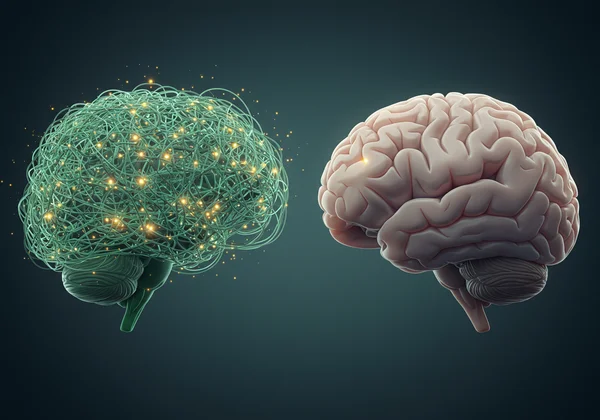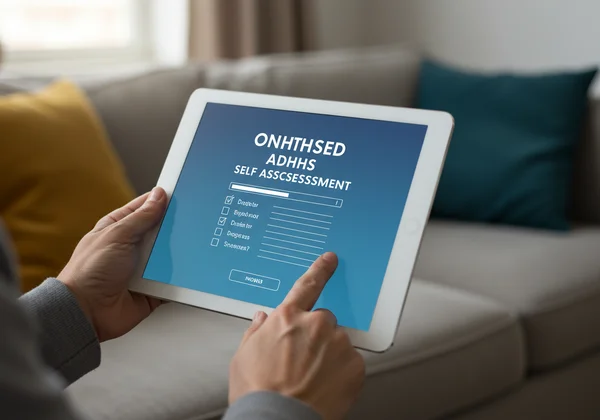ADHD Test & Symptoms: Ultimate Guide from Childhood to Adulthood
Have you ever found yourself wondering if your constant distractibility, your child's boundless energy, or your lifelong struggle with deadlines is just a personality quirk or something more? The term ADHD symptoms is widely discussed, yet deeply misunderstood, leading many to feel isolated and confused. What are the symptoms of ADHD, and how do they truly appear in daily life, not just in stereotypes? This guide will unravel the signs of ADHD from the playground to the workplace, offering clarity for yourself, your child, or a loved one.
Understanding these traits is the first step toward gaining control and seeking support. If you recognize yourself or someone you care about in the descriptions that follow, a great next step is to explore a confidential and reliable screening tool. You can start a self assessment to get a personalized report that can help organize your thoughts before seeking professional advice.
What Exactly Is ADHD? Decoding the Core Condition
Attention-Deficit/Hyperactivity Disorder (ADHD) is a neurodevelopmental condition that affects how the brain manages attention, impulsivity, and activity levels. It's not a matter of willpower or intelligence but a difference in brain wiring related to executive functions. These functions include skills like planning, focusing, remembering instructions, and multitasking. When these are impaired, it can create significant challenges in school, at work, and in personal relationships.

The Three Primary Presentations of ADHD: Inattentive, Hyperactive-Impulsive, Combined
ADHD isn't a one-size-fits-all condition. It manifests in three distinct ways, known as presentations:
- Predominantly Inattentive Presentation: Individuals often struggle with paying close attention to details, sustaining focus, and organizing tasks. They may seem forgetful, lose things frequently, and appear to be daydreaming. This type was once commonly referred to as ADD.
- Predominantly Hyperactive-Impulsive Presentation: This is characterized by a need for constant movement. People may fidget, talk excessively, and feel restless. Impulsivity can lead to interrupting others, making hasty decisions, and struggling with self-control.
- Combined Presentation: This is the most common form of ADHD, where an individual meets the criteria for both inattentive and hyperactive-impulsive symptoms.
Understanding DSM-5 Criteria for ADHD: A Brief Overview
To ensure a standardized approach, mental health professionals use the Diagnostic and Statistical Manual of Mental Disorders, 5th Edition (DSM-5). This diagnostic manual outlines specific criteria for identifying ADHD. It requires a persistent pattern of inattention and/or hyperactivity-impulsivity that interferes with functioning or development. Several symptoms must have been present before the age of 12 and be noticeable in two or more settings, such as at home and school.
Recognizing Child ADHD Symptoms: What Parents Should Know
For parents, distinguishing between typical childhood behavior and potential child ADHD symptoms can be incredibly difficult. While most children have moments of inattention or high energy, for kids with ADHD, these behaviors are persistent and impact their ability to succeed socially and academically. An ADHD test for kids can be a helpful starting point to gather information.
Common Inattentive Behaviors in Youngsters
A child with inattentive symptoms might not be disruptive, making their struggles easy to overlook. Watch for these focus issues:
- Making careless mistakes in schoolwork.
- Difficulty staying focused during play or tasks.
- Not seeming to listen when spoken to directly.
- Failing to finish chores or homework.
- Losing essentials like toys, pencils, or assignments.
Hyperactive-Impulsive Signs in Kids: Beyond Just "Fidgety"
Hyperactivity in children is more than just being energetic. It's a pattern of constant motion that is inappropriate for their age and setting. Impulsivity involves acting without thinking. Signs include:
- Fidgeting with hands or feet, or squirming in their seat.
- Leaving their seat when expected to remain seated.
- Running or climbing in inappropriate situations.
- Being unable to play quietly.
- Blurting out answers before questions are completed.
- Having trouble waiting their turn.
How ADHD Symptoms Manifest in School & Social Settings
In a structured environment like school, ADHD symptoms often become more apparent. Academic struggles may arise from an inability to follow multi-step instructions or organize assignments. Socially, impulsive behaviors like interrupting or having difficulty sharing can make it hard for a child to build and maintain friendships, leading to feelings of frustration and isolation.

Adult ADHD Symptoms: Often Missed and Misunderstood
For decades, ADHD was considered a childhood disorder that people outgrew. We now know that adult ADHD symptoms are real and can significantly impact an individual's life. Many adults with ADHD were never diagnosed as children, especially if their symptoms were primarily inattentive. They may have spent years believing they were lazy, disorganized, or simply not trying hard enough. A free adult ADHD test can provide valuable insights.
Subtle Signs of Inattentive ADHD in Adults: The Quiet Struggles
In adults, inattention often looks different. It's less about staring out the window and more about internal chaos and organization challenges. These struggles can manifest as:
- Chronic procrastination and trouble starting tasks.
- Poor time management and consistently underestimating how long tasks will take.
- Difficulty keeping their living or workspace tidy.
- Frequently misplacing keys, wallets, or phones.
- Zoning out during conversations or meetings.
Hyperactivity and Impulsivity in Adulthood: Shifting Manifestations
Overt hyperactivity often lessens with age, transforming into a feeling of internal restlessness. Impulsivity, however, can remain a significant issue. In adults, this might look like:
- Choosing a job that is highly active or constantly changing.
- Fidgeting during meetings or feeling antsy when sitting still.
- Impulsive spending and poor financial management.
- Making major life decisions on a whim.
- A history of frequent job changes or relationship turnover.
Impact of Adult ADHD on Relationships, Career, and Daily Life
The cumulative effect of untreated adult ADHD can be profound. In relationships, forgetfulness and difficulty listening can be misinterpreted as carelessness. Professionally, missed deadlines and disorganization can hinder career growth. The constant effort to manage daily life can lead to chronic stress, low self-esteem, and burnout.

ADHD in Teens and Adolescents: Navigating a Complex Stage
Adolescence is a period of intense change, and ADHD can make it even more turbulent. The demand for greater independence and self-management often exposes underlying executive function difficulties that were less apparent in childhood.
Academic Challenges & Behavioral Shifts in Teenagers
As schoolwork becomes more complex, teens with ADHD may struggle with long-term projects, studying for exams, and managing a varied class schedule. This can lead to a drop in grades and increased conflict at home over school performance. They may also engage in more risk-taking behaviors due to impulsivity.
Social Dynamics and Emotional Regulation for Adolescents with ADHD
Teens with ADHD often experience emotions more intensely, and their challenges with emotional regulation can strain friendships. They may be perceived as overly sensitive or quick to anger. Navigating the complex social landscape of adolescence is difficult for any teen, but it can be especially challenging for those struggling to manage their impulses and attention.
Beyond Stereotypes: ADHD Symptoms in Women & Girls
The classic image of ADHD is a young boy who can't sit still. This stereotype has caused generations of girls and women to be overlooked. An ADHD test for women is a crucial tool because the condition often presents differently in females, leading to misdiagnosis or no diagnosis at all.
Internalized Symptoms and Masking: Why ADHD in Females is Often Missed
Girls with ADHD are more likely to have the inattentive presentation. Their symptoms are often internalized—they may be seen as shy, anxious, or spacey rather than disruptive. Many develop sophisticated coping strategies, known as masking, to hide their struggles with focus and organization, which can be mentally and emotionally exhausting.
Common Misdiagnoses and Co-occurring Conditions
Because their core ADHD symptoms are missed, many women are first diagnosed with co-occurring conditions like anxiety or depression. While these conditions are very real, they are sometimes secondary to the chronic stress of living with undiagnosed ADHD. Recognizing the underlying ADHD is key to effective treatment.

Your Next Steps: From Understanding ADHD Symptoms to Action
Recognizing ADHD symptoms in yourself or someone you love is a powerful act of awareness. It reframes challenges not as personal failings but as signs of a different neurological wiring. This knowledge opens the door to self-compassion, effective strategies, and the right kind of support. The journey begins with a single step: gaining clarity.
If this guide has resonated with you, don't stop here. The next logical move is to translate your questions into answers. We invite you to take our free ADHD test today. It's a confidential, convenient online ADHD test designed for all ages, offering an AI-powered, personalized report to help you understand your unique traits. This is your first step toward a more informed future.

Frequently Asked Questions About ADHD Symptoms & Screening
How can I tell if I have ADHD symptoms?
Recognizing potential ADHD symptoms involves observing persistent patterns of inattention, hyperactivity, or impulsivity that impact your daily functioning. If you consistently struggle with focus, organization, restlessness, or making rash decisions in multiple areas of your life (e.g., work and home), it may be worth exploring further. A self-assessment can help you structure your observations.
Can an online ADHD test accurately identify symptoms?
An online ADHD screening tool is an excellent first step for identifying potential ADHD traits. It is important to remember that these tests are for screening purposes and do not provide a medical diagnosis. The report from our online ADHD screening can provide valuable, structured insights that you can then discuss with a healthcare professional, who can conduct a comprehensive evaluation for a formal diagnosis.
What should I do if I recognize these ADHD symptoms in myself or my child?
If you recognize these symptoms, the first step is to gather more information in a structured way. Taking a free, confidential ADHD self assessment test can provide a detailed overview of relevant traits. After you get your results, the next recommended step is to schedule an appointment with a qualified healthcare provider, such as a psychologist, psychiatrist, or primary care physician, to discuss the findings and explore options for a formal evaluation and support.
Is there a difference between ADHD and Autism symptoms?
Yes, while there can be some overlap, ADHD and Autism are distinct conditions. ADHD's core challenges relate to attention regulation, impulsivity, and hyperactivity. Autism Spectrum Disorder (ASD) is primarily characterized by challenges with social communication and interaction, along with restricted or repetitive behaviors and interests. A professional evaluation is necessary to distinguish between them, as they require different support strategies.